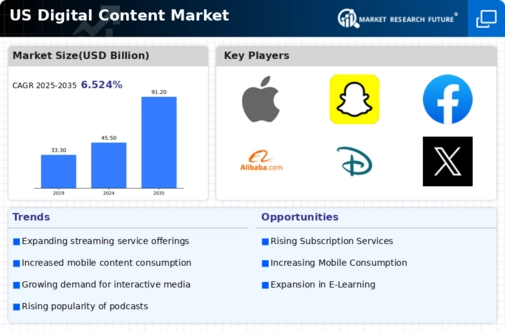Surge in Mobile Consumption
The digital content market is experiencing a notable surge in mobile consumption, driven by the increasing penetration of smartphones and tablets across the United States. As of 2025, mobile devices account for approximately 70% of all digital content consumption, indicating a shift in user behavior towards on-the-go access. This trend is further supported by advancements in mobile internet speeds, with 5G technology enhancing streaming capabilities. Consequently, content creators and distributors are adapting their strategies to optimize content for mobile platforms, which is likely to lead to increased engagement and revenue generation. The digital content market must prioritize mobile-friendly formats to capture this growing audience, as failure to do so may result in missed opportunities in a rapidly evolving landscape.
Rise of User-Generated Content
User-generated content (UGC) is gaining traction within the digital content market, as consumers increasingly seek authentic and relatable experiences. This trend is particularly pronounced among younger demographics, who favor content created by peers over traditional advertising. In 2025, it is estimated that UGC will account for nearly 40% of all digital content consumed in the United States. Brands are recognizing the value of UGC in building trust and fostering community engagement, prompting them to incorporate such content into their marketing strategies. The digital content market must navigate this shift by encouraging and curating UGC, as it not only enhances brand loyalty but also drives organic reach and engagement.
Expansion of Streaming Platforms
The expansion of streaming platforms is reshaping the digital content market, as consumers increasingly favor on-demand access to a wide array of content. By 2025, the number of streaming subscribers in the United States is projected to exceed 200 million, reflecting a growing preference for subscription-based models. This trend is prompting traditional media companies to adapt their business models, as they compete with emerging platforms that offer diverse content libraries. The digital content market is likely to see further innovation in content delivery, with platforms investing in original programming to attract and retain subscribers. As competition intensifies, the focus on quality and exclusivity will be paramount for success in this evolving landscape.
Growth of E-commerce Integration
The integration of e-commerce within the digital content market is witnessing substantial growth, as brands increasingly leverage content to drive sales. In 2025, it is projected that over 50% of digital content will incorporate shoppable features, allowing consumers to purchase products directly from content platforms. This trend reflects a shift towards a more interactive and engaging shopping experience, where content serves as a catalyst for consumer decision-making. The digital content market is adapting to this change by developing strategies that blend entertainment with commerce, thereby enhancing monetization opportunities. As e-commerce continues to evolve, the synergy between content and commerce is likely to redefine consumer engagement and purchasing behavior.
Emergence of Artificial Intelligence
Artificial intelligence (AI) is emerging as a transformative force within the digital content market. AI technologies are being utilized to analyze consumer behavior, enabling personalized content recommendations that enhance user experience. In 2025, it is estimated that AI-driven content curation could increase user engagement by up to 30%. Furthermore, AI tools are streamlining content creation processes, allowing for more efficient production and distribution. This technological advancement is reshaping the digital content market, as businesses leverage AI to gain competitive advantages. The integration of AI not only improves operational efficiency but also fosters innovation in content delivery, suggesting a promising future for those who embrace these technologies.
















